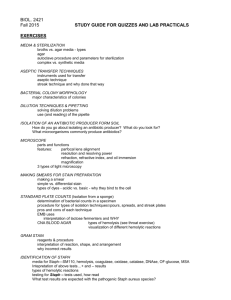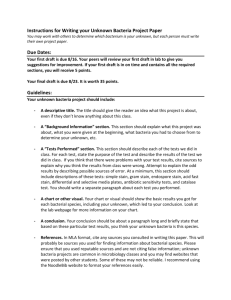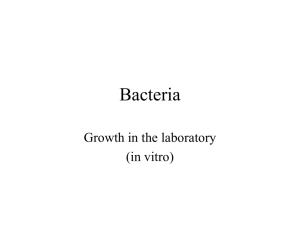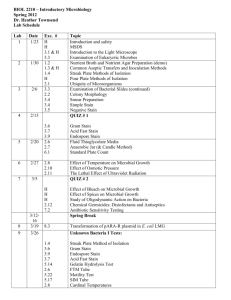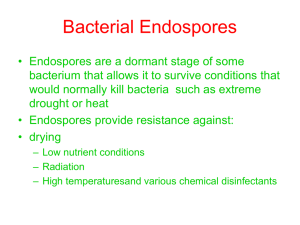Lab Study Guide
advertisement
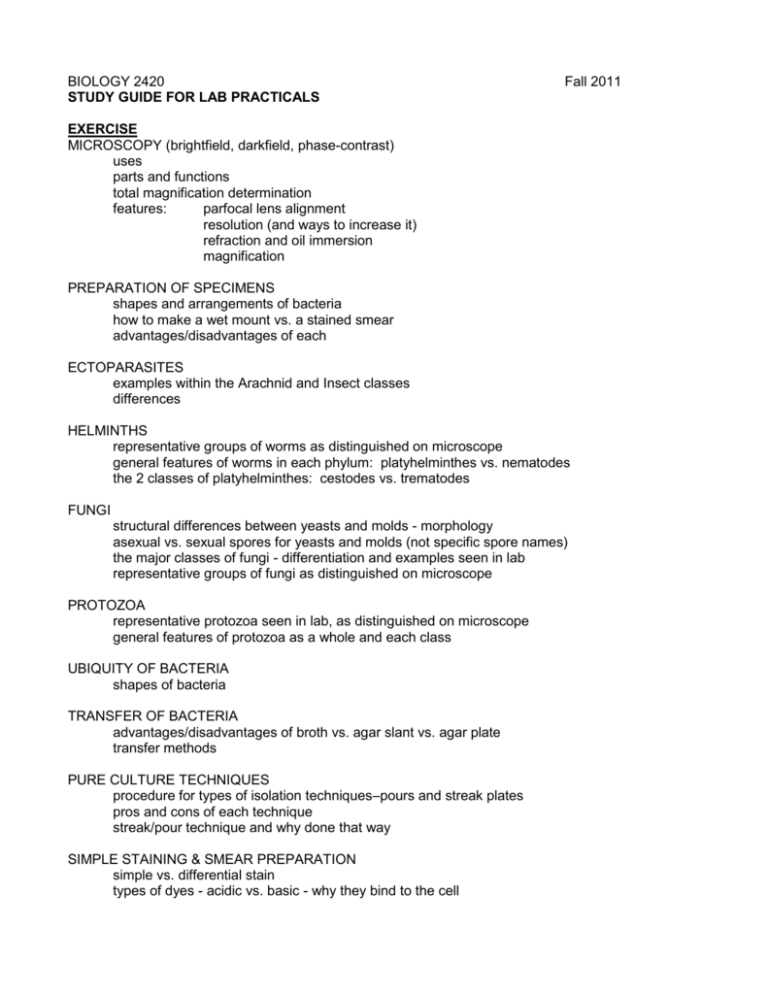
BIOLOGY 2420 STUDY GUIDE FOR LAB PRACTICALS Fall 2011 EXERCISE MICROSCOPY (brightfield, darkfield, phase-contrast) uses parts and functions total magnification determination features: parfocal lens alignment resolution (and ways to increase it) refraction and oil immersion magnification PREPARATION OF SPECIMENS shapes and arrangements of bacteria how to make a wet mount vs. a stained smear advantages/disadvantages of each ECTOPARASITES examples within the Arachnid and Insect classes differences HELMINTHS representative groups of worms as distinguished on microscope general features of worms in each phylum: platyhelminthes vs. nematodes the 2 classes of platyhelminthes: cestodes vs. trematodes FUNGI structural differences between yeasts and molds - morphology asexual vs. sexual spores for yeasts and molds (not specific spore names) the major classes of fungi - differentiation and examples seen in lab representative groups of fungi as distinguished on microscope PROTOZOA representative protozoa seen in lab, as distinguished on microscope general features of protozoa as a whole and each class UBIQUITY OF BACTERIA shapes of bacteria TRANSFER OF BACTERIA advantages/disadvantages of broth vs. agar slant vs. agar plate transfer methods PURE CULTURE TECHNIQUES procedure for types of isolation techniques–pours and streak plates pros and cons of each technique streak/pour technique and why done that way SIMPLE STAINING & SMEAR PREPARATION simple vs. differential stain types of dyes - acidic vs. basic - why they bind to the cell GRAM STAIN reagents & procedure interpretation of reaction, shape, and arrangement why incorrect results SPORE STAIN reagents & interpretation example of spore formers ACID-FAST STAIN reagents & interpretation example of acid-fast bacteria MOTILITY (flagella stain, SIM, TTC motility, hanging drops) true vs. false motility (Brownian movement) example of flagellation types interpretation of motility in TTC media CAPSULE STAINS interpretation PIPETTING & DILUTIONS solving dilution problems use (and reading) of the pipette COUNTING BACTERIA - STANDARD PLATE COUNT & TURBIDEMETRY determination of bacterial counts in a specimen use of spectrophotometer (basics of what it is reading) use of a graph to quesstimate bacterial counts ENVIRONMENTAL INFLUENCES: pH, osmotic pressure effects of pH, and osmotic pressure on life effect of hypertonic media on growth halophiles/osmophiles UV LIGHT mechanism of kill limitations of UV kill EFFECTS OF TEMPERATURE ON GROWTH classification based on optimal temperatures KIRBY-BAUER TEST FOR ANTIBIOTIC SENSITIVITIES zones of inhibition determination of S, R, and I (with a chart) ANAEROBES ways to culture according to oxygen needs candle jar vs. GasPak jar - how they work, what atmosphere thioglycollate broth classification of microbes according to oxygen needs BIOCHEMICAL TESTS FOR IDENTIFICATION OF BACTERIA For the following tests–the medium used, purpose, interpretation (+ vs. -), reagent used gelatin hydrolysis sugar use (phenol red sugars) IMViC tests MRVP (methyl red and Voges-Proskauer tests) indole production citrate utilization nitrate reduction catalase test oxidase test starch hydrolysis lipid hydrolysis casein hydrolysis indole test (in SIM) urea hydrolysis hydrogen sulfide phenylalanine deamination, arginine/lysine/ornithine decarboxylases litmus milk API20E pros and cons uses STAPHYLOCOCCUS ID tests for differentiating the genus Staph and its species For any tests/media–purpose, interpretation (+ vs. -), reagent used hemolytic reactions on blood agar STREPTOCOCCUS ID tests for differentiating the genus Strep and its species For any media/tests run–purpose, interpretation (+ vs. -), reagent used hemolytic reactions on blood agar BACTERIOPHAGES the major points in technique and reasoning lytic vs. lysogenic infection determination of number of viruses/ml plaques SEROLOGICAL LATEX SLIDE AGGLUTINATION: STAPH, STREP, and MONOSPOT basics of the antigen-antibody test purpose of the latex beads interpretation URINE CULTURE the bacterial counts that indicate a urinary tract infection bacterial found in urine CAN and EMB media how to obtain a midstream clean catch urine specimen calculating bacterial numbers in a urine specimen
